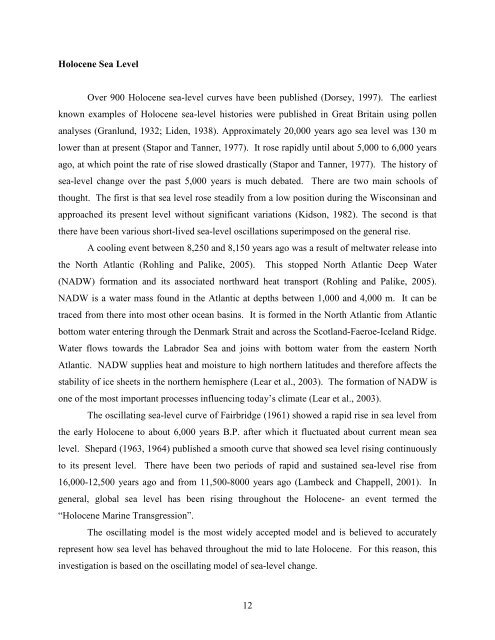the florida state university college of arts and sciences evolution of ...
the florida state university college of arts and sciences evolution of ...
the florida state university college of arts and sciences evolution of ...
Create successful ePaper yourself
Turn your PDF publications into a flip-book with our unique Google optimized e-Paper software.
Holocene Sea Level<br />
Over 900 Holocene sea-level curves have been published (Dorsey, 1997). The earliest<br />
known examples <strong>of</strong> Holocene sea-level histories were published in Great Britain using pollen<br />
analyses (Granlund, 1932; Liden, 1938). Approximately 20,000 years ago sea level was 130 m<br />
lower than at present (Stapor <strong>and</strong> Tanner, 1977). It rose rapidly until about 5,000 to 6,000 years<br />
ago, at which point <strong>the</strong> rate <strong>of</strong> rise slowed drastically (Stapor <strong>and</strong> Tanner, 1977). The history <strong>of</strong><br />
sea-level change over <strong>the</strong> past 5,000 years is much debated. There are two main schools <strong>of</strong><br />
thought. The first is that sea level rose steadily from a low position during <strong>the</strong> Wisconsinan <strong>and</strong><br />
approached its present level without significant variations (Kidson, 1982). The second is that<br />
<strong>the</strong>re have been various short-lived sea-level oscillations superimposed on <strong>the</strong> general rise.<br />
A cooling event between 8,250 <strong>and</strong> 8,150 years ago was a result <strong>of</strong> meltwater release into<br />
<strong>the</strong> North Atlantic (Rohling <strong>and</strong> Palike, 2005). This stopped North Atlantic Deep Water<br />
(NADW) formation <strong>and</strong> its associated northward heat transport (Rohling <strong>and</strong> Palike, 2005).<br />
NADW is a water mass found in <strong>the</strong> Atlantic at depths between 1,000 <strong>and</strong> 4,000 m. It can be<br />
traced from <strong>the</strong>re into most o<strong>the</strong>r ocean basins. It is formed in <strong>the</strong> North Atlantic from Atlantic<br />
bottom water entering through <strong>the</strong> Denmark Strait <strong>and</strong> across <strong>the</strong> Scotl<strong>and</strong>-Faeroe-Icel<strong>and</strong> Ridge.<br />
Water flows towards <strong>the</strong> Labrador Sea <strong>and</strong> joins with bottom water from <strong>the</strong> eastern North<br />
Atlantic. NADW supplies heat <strong>and</strong> moisture to high nor<strong>the</strong>rn latitudes <strong>and</strong> <strong>the</strong>refore affects <strong>the</strong><br />
stability <strong>of</strong> ice sheets in <strong>the</strong> nor<strong>the</strong>rn hemisphere (Lear et al., 2003). The formation <strong>of</strong> NADW is<br />
one <strong>of</strong> <strong>the</strong> most important processes influencing today’s climate (Lear et al., 2003).<br />
The oscillating sea-level curve <strong>of</strong> Fairbridge (1961) showed a rapid rise in sea level from<br />
<strong>the</strong> early Holocene to about 6,000 years B.P. after which it fluctuated about current mean sea<br />
level. Shepard (1963, 1964) published a smooth curve that showed sea level rising continuously<br />
to its present level. There have been two periods <strong>of</strong> rapid <strong>and</strong> sustained sea-level rise from<br />
16,000-12,500 years ago <strong>and</strong> from 11,500-8000 years ago (Lambeck <strong>and</strong> Chappell, 2001). In<br />
general, global sea level has been rising throughout <strong>the</strong> Holocene- an event termed <strong>the</strong><br />
“Holocene Marine Transgression”.<br />
The oscillating model is <strong>the</strong> most widely accepted model <strong>and</strong> is believed to accurately<br />
represent how sea level has behaved throughout <strong>the</strong> mid to late Holocene. For this reason, this<br />
investigation is based on <strong>the</strong> oscillating model <strong>of</strong> sea-level change.<br />
12

















